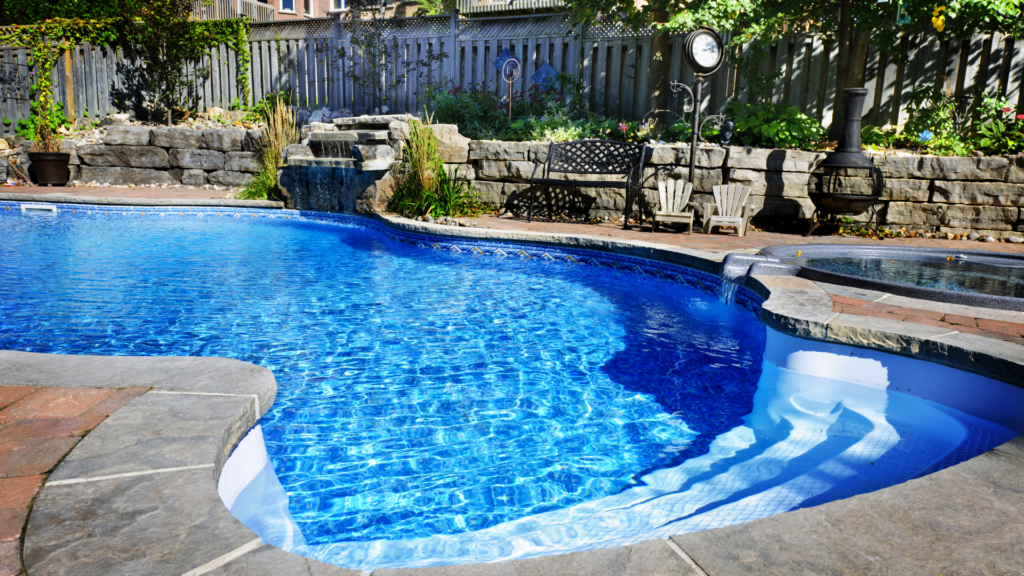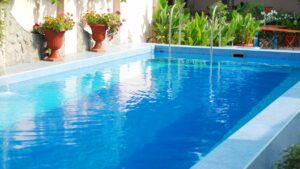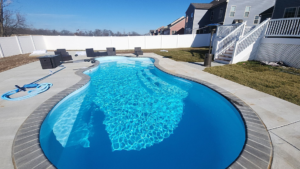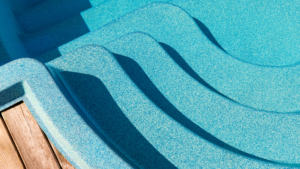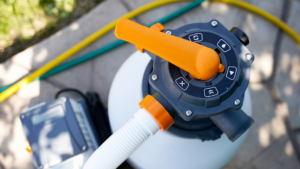Choosing the right inground pool for your home can feel overwhelming. With so many options available, it’s hard to know where to start. Whether you’re looking for a place to cool off in the summer, a spot for family gatherings, or simply want to add value and beauty to your property, selecting the perfect pool type is crucial.
Fortunately, there’s good news: Fiberglass pools are known as the simplest and least expensive type of inground pool to install.
This guide dives into the four basic types of inground pools: concrete with different finishes, fiberglass, and vinyl. We’ll discuss important factors such as cost, installation timeframes, maintenance needs, durability concerns, design flexibility which all play significant roles in choosing an ideal pool for your backyard oasis.
By comparing these materials and their benefits or drawbacks comprehensively—alongside popular uses and ideal locations—we aim to simplify your decision-making process.
Discover how easy finding the perfect swimming space can be!
Four Basic Types of Inground Pools
Diving into the world of inground pools reveals a variety of construction materials and designs, each offering unique benefits to homeowners. Exploring these options can unlock personalized swimming experiences, from sleek fiberglass shapes to elegant concrete masterpieces.
Concrete with plaster or aggregate finishes
Concrete pools with plaster or aggregate finishes offer homeowners a classic and customizable option for their inground swimming pool design. These materials, being the first used in residential pool construction, have stood the test of time due to their durability and flexibility in design.
Concrete forms the base, while plaster provides a smooth finish or aggregates like stones, pebbles, and glass beads add texture and color for visual interest.
Choosing between a plaster or an aggregate finish depends on your aesthetic preference and budget. Plaster is more cost-effective but may require more frequent resurfacing. Aggregates, on the other hand, can enhance your pool’s aesthetics with their varied colors and textures but might increase initial installation costs.
Each offers its unique appeal to match your swimming pool renovation or installation vision while ensuring longevity with proper pool maintenance.
Concrete and tile or stone
Homeowners often choose concrete and tile or stone for custom-shaped pools due to its unmatched durability. This combination allows for a strong, long-lasting pool foundation while providing ample opportunity for aesthetic customization.
The construction process involves mixing water, cement, sand, and coarse aggregates like gravel or stone. Such a mix not only ensures the structural integrity of the pool but also supports various finishes including tiles and stones that add visual appeal.
Opting for concrete with tile or stone finish means embracing flexibility in design coupled with resilience. These materials stand up well over time and can handle almost any weather condition without significant damage.
With options ranging from sleek tiles to rustic stone finishes, this choice offers homeowners a unique way to express their style through their inground pool’s look and feel.
Fiberglass
Fiberglass inground pools offer a compelling option for those seeking durability with minimal fuss. These pools arrive pre-fabricated, making them the simplest and least expensive type to install, which appeals greatly to homeowners looking for efficiency in pool construction.
Despite their higher initial cost, fiberglass pools save money over time thanks to their low maintenance requirements. Unlike other types, these don’t need frequent resurfacing or liner replacements.
Their smooth surface discourages algae growth, further reducing cleaning efforts and costs. However, potential buyers should consider the size limitations due to the pre-fabricated nature of fiberglass pools.
While this might restrict customization options somewhat, the longevity and ease of care often tip the scales in favor of choosing fiberglass for your backyard oasis.
Vinyl
Vinyl liner pools stand out as a more budget-friendly choice compared to concrete counterparts, offering homeowners a lower initial installation cost.
This aspect makes them particularly appealing for individuals looking to enjoy the luxury of a private pool without breaking the bank.
Vinyl also shines in its vast array of design possibilities. Homeowners can select from numerous colors and patterns to personalize their swimming oasis, ensuring it complements their outdoor decor seamlessly.
Moreover, these pools are celebrated for their smooth surface—enhancing comfort during swim sessions by minimizing scrapes and bruises. Despite these benefits, it’s crucial to note that vinyl pools might demand more upkeep over time than other types of inground pools.
Opting for a vinyl liner involves weighing the trade-offs between cost savings and potential maintenance tasks to keep your pool in pristine condition.
Factors to Consider When Choosing an Inground Pool
Selecting the right in-ground pool involves weighing diverse aspects that influence your swimming experience and property value. Explore further to find a perfect match for your lifestyle and backyard oasis.
Cost
Considering the cost is essential when choosing an inground pool, as expenses can vary widely based on type, size, materials used, and additional features. Installation costs for inground pools typically range between $55,000 to $130,000.
Homeowners should also factor in the long-term maintenance expenses which will add to the total cost of ownership.
Budgeting accurately requires understanding that smaller fiberglass pools start at around $55,000 but could increase with more elaborate design options and accessories. Pool budget discussions should include initial construction costs along with ongoing maintenance needs to ensure a clear picture of the financial commitment involved.
Assessing these factors early helps in making informed decisions that align with both desires and financial parameters.
Installation
After examining the cost aspects of in-ground pools, it’s crucial to focus on the installation process. This stage involves assessing soil stability and conducting a thorough slope analysis.
Professionals must also evaluate drainage conditions and inspect for any utility lines that might affect construction safety and efficiency. These preliminary steps ensure your ground pool installation adheres to zoning regulations while optimizing for a longlasting pool structure.
The quality of construction materials, along with an effective circulation system, plays a significant role in the longevity of your underground pool. Ensuring these components meet high standards will lead to fewer maintenance issues down the line.
Proper planning during this phase avoids future complications, providing homeowners with peace of mind about their investment in outdoor leisure and entertainment spaces.
Maintenance
Maintaining an inground pool requires consistent attention to keep the water chemistry balanced and the structure in prime condition. This involves regular checks of pH levels, chlorine, and other chemicals to ensure a clean, safe swimming environment.
Homeowners must also clear debris from the pool and its filters while monitoring for any signs of wear or damage that could require repairs.
Fiberglass pools present an attractive option for those seeking lower maintenance efforts due to their non-porous surface that resists algae growth, making them easier to clean. Despite having a higher initial cost compared with other types, they offer savings over time through reduced upkeep needs.
No matter the type of inground pool chosen, understanding its specific care requirements will help new pool owners sustain their investment’s value and enjoyment factor for years to come.
Durability
Durability stands as a critical factor for homeowners pondering the decision of installing an inground pool. Pools crafted from concrete boast an impressive lifespan, enduring up to 50 years with diligent care.
This resilience is attributed to their robust construction and capacity to withstand various weather conditions without significant damage.
Fiberglass and gunite pools parallel this longevity, promising nearly half a century of reliability without necessitating major repairs or replacements. Their sturdiness ensures that your backyard oasis remains a source of joy and relaxation year after year, reinforcing the importance of choosing materials known for their solidity and resistance against natural wear and tear.
Design options
Exploring design options allows homeowners to customize their inground pool to fit their lifestyle and backyard aesthetic. Shape plays a critical role; whether rectangular, freeform, or another unique formation, the choice shapes the pool’s overall look and how it blends with the surroundings.
Materials like fiberglass, vinyl, and concrete offer varying textures and colors for creating a distinct appearance. These elements combine to reflect personal tastes while considering pool longevity and maintenance needs.
Choosing between saltwater and chlorine systems impacts not only the water feel but also factors into maintenance routines and costs over the pool’s lifespan. Each material responds differently to these systems, influencing decisions on pool construction based on desired ease of care and long-term durability.
As you consider these design aspects, keep in mind how they align with your preferences for usage, upkeep, and budget constraints.
Comparing Types of Inground Pools
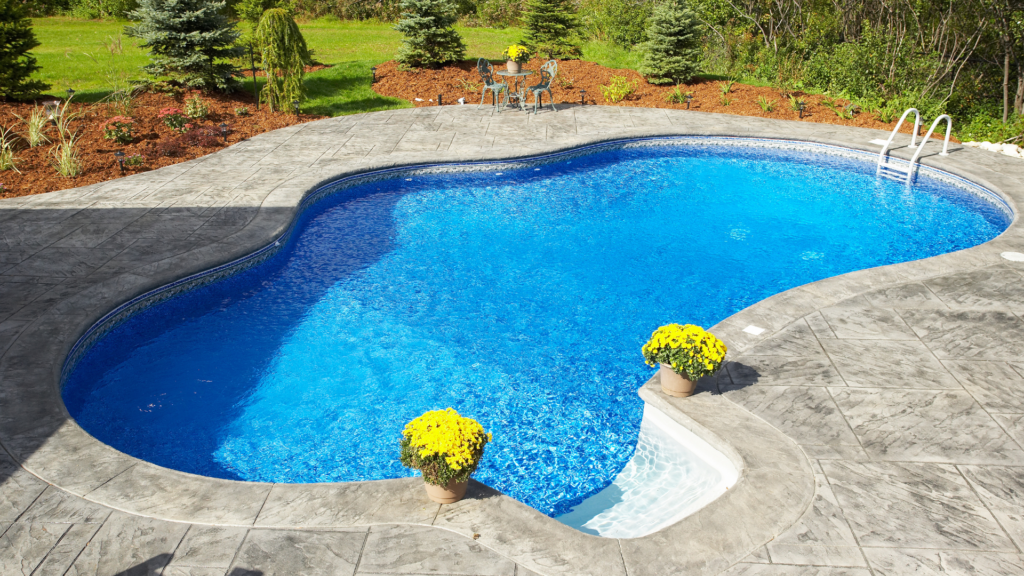
Discover how each type of in-ground pool stands up against the others, taking a closer look at their advantages and challenges to help you decide which fits your needs best.
Ideal locations
Transitioning from understanding the popular uses of each pool type, it becomes crucial to examine the ideal locations for installing an in-ground pool. This consideration is paramount as factors like landscape, budget, and future plans significantly influence the decision-making process. Equally, the choice of swimming pool construction, materials, and functions should align with the chosen location to ensure the best outcome.
| Type of In-Ground Pool | Ideal Locations |
|---|---|
| Concrete with plaster or aggregate finishes | Areas with fluctuating temperatures; suited for customization in both shape and size to fit specific landscape needs |
| Concrete and tile or stone | Luxurious properties or those aiming for a high-end aesthetic; works well in regions with stable temperatures |
| Fiberglass | Locations seeking quick installation and minimal long-term maintenance; ideal for climates that don’t fluctuate wildly |
| Vinyl | Cost-effective for colder climates due to its resistance to cracking; suitable for homeowners looking for lower upfront costs |
Each pool type caters to distinct preferences and logistical considerations. Homeowners should meticulously consider these aspects to select the most fitting in-ground pool type for their property. This decision directly impacts not only the aesthetic appeal and usability of the pool but also its long-term durability and maintenance requirements.
Benefits of San Juan Fiberglass Pools
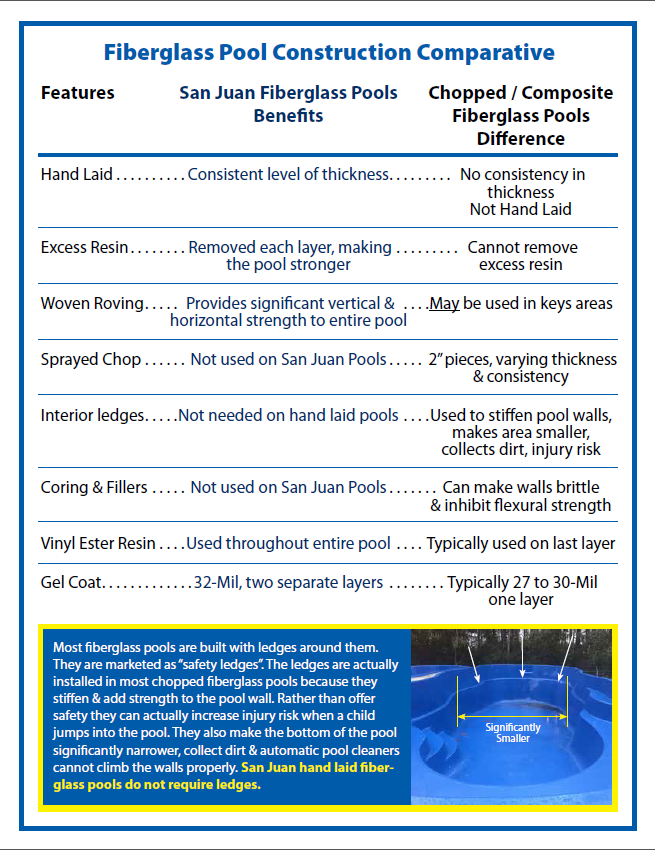
Splash Fiberglass Pool Co. is a proud installer of Suan Juan Fiberglass Pools. Each pool is carefully hand-laid to ensure a consistent level of thickness, providing our customers with peace of mind regarding longevity and maintenance. With a San Juan pool, you not only get a beautiful centerpiece for your backyard but also a product known for its strength and resistance to wear and tear.
Contact Splash Fiberglass Pool Co. to Install Your Inground Pool
Exploring the different types of inground pools equips homeowners with the knowledge to make informed decisions. Each pool type offers unique benefits, from cost-effectiveness to customization options.
Understanding factors like maintenance, durability, and installation helps in selecting the perfect pool. This guide serves as an essential tool for anyone planning to add a swimming pool to their home. Splash Fiberglass Pool Co. has been installing inground pools in Maryland for decades! Contact us today to get started on your pool!
FAQs
1. What are the main types of inground pools?
The main types of inground pools are concrete, vinyl liner, and fiberglass.
2. How long does it take to install an inground pool?
Installing an inground pool typically takes several weeks to a few months, depending on the type and complexity.
3. Can I customize the shape of my inground pool?
Yes, concrete pools offer the most flexibility for customization in shape and size.
4. Are there eco-friendly options for inground pools?
Fiberglass pools are known for their eco-friendly attributes due to lower chemical usage and energy efficiency.
5. How often do I need to maintain my inground pool?
Regular maintenance is required weekly to keep your inground pool clean and safe for swimming.
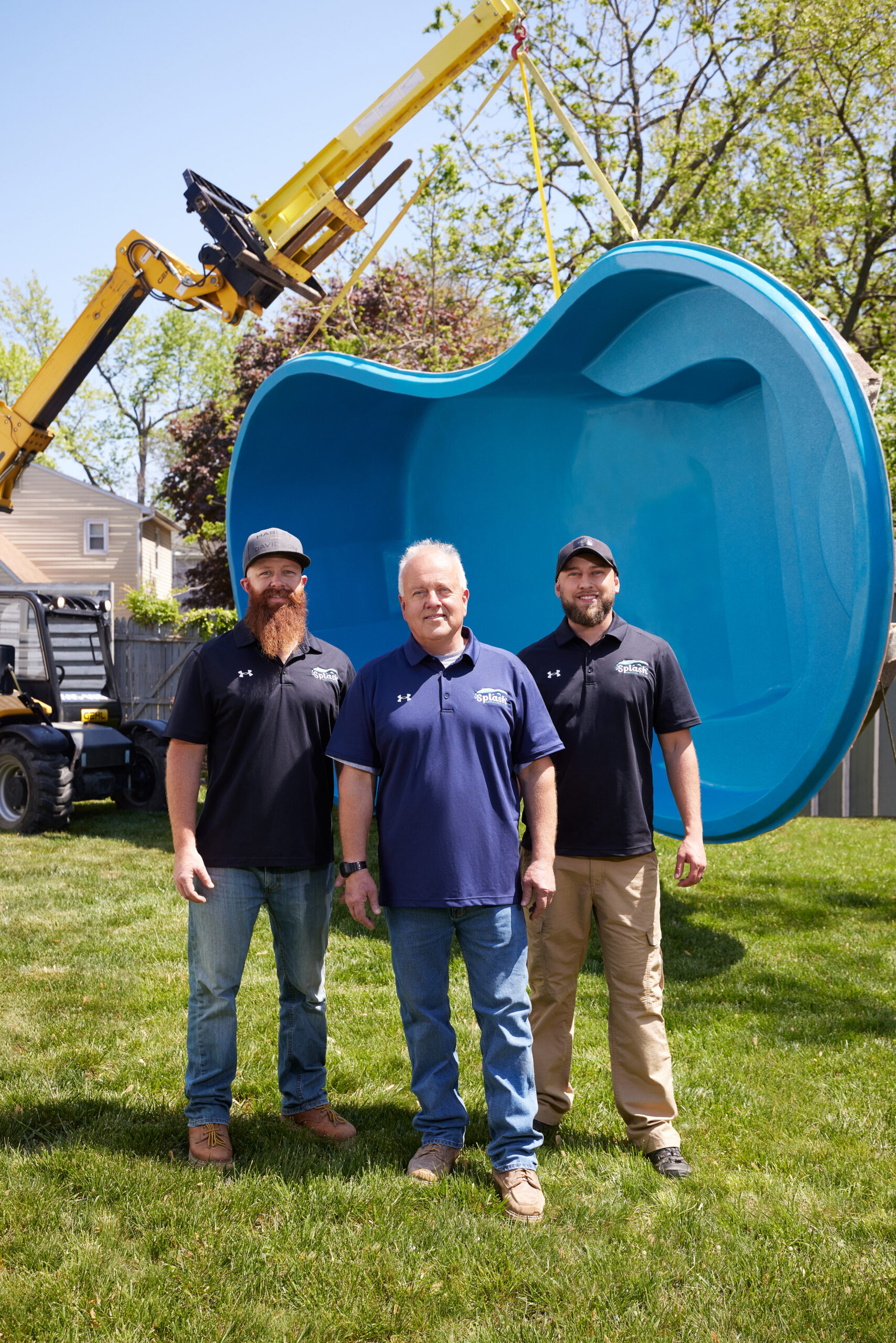
Sean Locklear spearheads Splash Fiberglass Pool Co., where his passion for creating the perfect backyard oasis drives the company’s success. Specializing in high-quality fiberglass pools, Sean’s approach combines innovative design with functionality, ensuring each pool installation enhances outdoor living spaces. Under his leadership, Splash Fiberglass Pool Co. is dedicated to delivering dream pools that are durable, low maintenance, and beautifully crafted, providing expertise on the benefits of fiberglass pools and customized design options.


